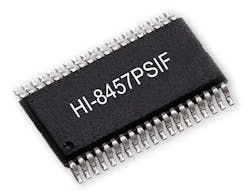ARINC 429 avionics databus receivers with lightning protection introduced by Holt
MISSION VIEJO, Calif., 17 Feb. 2016. Holt Integrated Circuits in Mission Viejo, Calif., is introducing an Octal ARINC 429 avionics databus interface line receiver family with integrated lightning protection circuitry.
The built-in circuitry ensures compliance with RTCA/DO-160G, section 22 level 3 pin injection test waveform set A (3 & 4), set B (3 & 5A) and set Z (3 & 5B), enabling direct connection to the ARINC 429 bus without external components. All devices operate from a 3.3- or 5-volt power supply and have eight independent ARINC 429 line receivers.
The family comprises three devices, HI-8456, HI-8457 and HI-8458. Each device is designed to operate in a high noise environment, with high input resistance and an input common mode voltage range of plus-or-minus 30 volts.
The HI-8456 and HI-8457 are exact drop-in replacements for DEI1046 and DEI1047 respectively. The HI-8458 is pin-to-pin compatible with Holt's popular HI-8448 and also is a drop-in replacement for the DEI1148 (44-pin PQFP).
Related: API for MIL-STD-1553 integrated terminal devices introduced by Holt Integrated Circuits
The devices have protection against non-annunciated system faults (where one side of the ARINC 429 bus transmission line becomes open or shorted to ground) or undefined ARINC 429 voltage levels (ranging between plus-or-minus 2.5 volts and plus-or-minus 6.5 volts). All signals received under these conditions are automatically rejected.
The HI-8456 and HI-8458 have test inputs which bypass the analog inputs for testing purposes. This allows the digital outputs of a transmitter to be connected to the test inputs through control logic for system self-test purposes. The HI-8456 has one test port which controls all 8 channels simultaneously, whereas the HI-8458 has two independent test ports, each controlling a bank of 4 channels.
The devices are available in numerous plastic packages including a 7-by-7-millimeter QFN. These devices operate in temperatures from -40 to 85 degrees Celsius, and -55 to 125 C devices are available with optional burn-in.
For more information contact Holt online at www.holtic.com.
